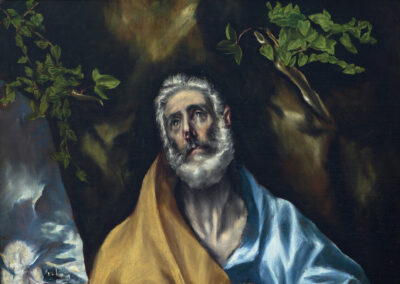Probably commissioned by the rector Pedro Salazar de Mendoza (1549-1629), the Hospital Tavera houses a canvas of The tears of St. Peter (ca. 1605), a logical iconography both because he is the patron saint of the patron and because Don Pedro was a penitentiary canon of Toledo Cathedral, and this iconography is considered one of the most representative of the male exercise of the sacrament of penance, due to his repentance and contrition. Saint Peter, his eyes bathed in tears due to his sense of guilt after denying Christ during the Passion, turns upwards begging for divine forgiveness while intertwining his hands in an intensely moving gesture of prayer; the half figure of the saint is silhouetted against a rock with ivy, a plant traditionally associated with irritation and weeping, a setting that seems to refer to the natural places in the deserts of penitent saints such as Saint Jerome and Saint Mary Magdalene. In the background of the painting is the tomb of Christ after the Resurrection, with the Angel seated on its cover and a figure of a man - sometimes interpreted as that of the resurrected Christ, but more probably that of Saint Peter himself after visiting the empty tomb (Luke, XXIV; John, XX) - and in other versions perhaps of a woman, who is moving away. In this iconography El Greco has apparently interwoven two Gospel passages, that of Simon Peter's visit to Golgotha (which does not appear in the Gospel of Mark, XVI) and that of St Peter's repentance which had taken place before the Crucifixion (Matthew, XXVI; Mark, XIV; Luke, XXII), and which would later be clarified by the inclusion in the scene of the cock crowing the dawn of Good Friday; the keys hanging from his left wrist allow his clear identification as Saint Peter and the foundation of the Church, confirming the forgiveness that emanated from penitence, but again transgress the chronological sequence of the Gospel narrative.
At his death in 1629, Salazar de Mendoza kept three canvases of San Pedro, ".at the top of the house"The painting is not attributed to the artist or, in this case, the typology of his image, although none of them - like any of those in his extensive collection - is specified; nevertheless, only this canvas appears in the 1762 inventory of the hospital's assets.
Signed on the lower left in cursive Greek characters " `epoiei", a Greek formula similar to the Latin "faciebat", this canvas is a late work in the Cretan painter's career; In this sense, it is close to the works of similar iconography and composition in the Cathedral and the Museo del Greco in Toledo, or to the one in the San Diego Museum of Art in San Diego (USA), while it differs from earlier versions of this subject, painted around 1585-1590, such as the one in the Bowes Museum at Barnard Castle in Durham (UK) [ ].
With this composition El Greco made a highly personal contribution to the iconography of the Catholic Counter-Reformation, which advocated the regular practice of penance as a means of achieving forgiveness of sins and ultimately salvation. The serial nature of the Candiota's work, of which a large number of versions are known, reduces the possibilities of the hypothesis that has sought to link the theme to the penitence and forgiveness of sinful priests and to make it allude to the request for forgiveness made by the archbishop of Toledo, Bartolomé Carranza de Miranda, who was accused and condemned in Rome by the Holy Inquisition of heresy. Although Salazar defended Carranza's good name as a historian and cathedral canon, and wrote his biography in defence of him and the church of Toledo, these contingent motifs do not seem sufficient to justify this highly successful iconography.
Any believing man could identify with Peter in his desire for forgiveness and not only before wishing for a good death and resurrection, which is alluded to in the background of the canvas; even in the Toledo hospital, which was concerned with both bodily health and spiritual salvation, a priest stood by each dying man's side, begging him to do penance and to repent of his sins before he died, in order to achieve his eternal salvation.
Fernando Marías, September 2008


